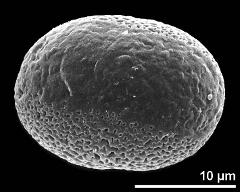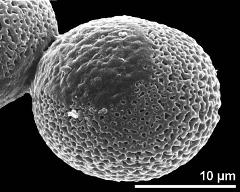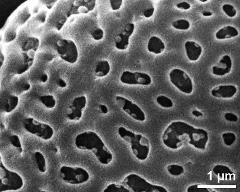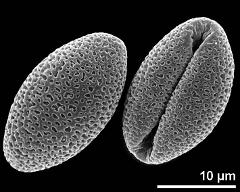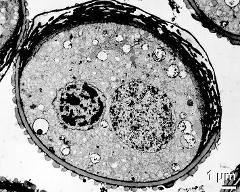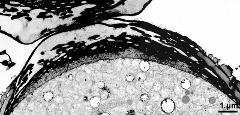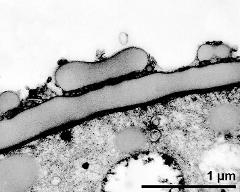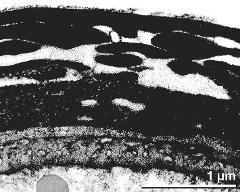Urospatha sagittifolia
Taxonomy: Angiospermae, Alismatales, Araceae, Urospatha
Published: 2016-11-03
Pollen Description
Shape, Size and Aperture
pollen unit: monad, dispersal unit and peculiarities: monad, size (pollen unit): medium-sized (26-50 µm), size of hydrated pollen (LM): -, shortest polar axis in equatorial view (LM): -, longest polar axis in equatorial view (LM): -, shortest diameter in equatorial or polar view (LM): -, longest diameter in equatorial or polar view (LM): -, pollen class: sulcate, polarity: heteropolar, P/E-ratio: oblate, shape: -, outline in polar view: elliptic, dominant orientation (LM): -, P/E-ratio (dry pollen): -, shape (dry pollen): boat-shaped, outline in polar view (dry pollen): elliptic, infoldings (dry pollen): aperture(s) sunken, aperture number: 1, aperture type: sulcus, aperture condition: sulcate, aperture peculiarities: aperture membrane psilate
Ornamentation and Structure
LM ornamentation LM: -, nexine: -, sexine: -, SEM ornamentation SEM: reticulate, suprasculpture SEM: -, TEM tectum: semitectate, infratectum: granular, foot layer: continuous, endexine: compact-continuous, intine: monolayered, wall peculiarities: -, supratectal element: -
Miscellaneous
pollen coatings: absent, reserves in cytoplasm: -, cell number: -, Ubisch bodies: -
Annotations: endexine and intine in interapertural area very thin
Author(s) of diagnosis: Weber, Martina; Halbritter, Heidemarie
Pictures
Picture legend
- polar view (distal) - fresh, rehydrated (water) & critical point dried & sputter coated with gold, photographer: Halbritter, H.
- equatorial view - fresh, rehydrated (water) & critical point dried & sputter coated with gold, photographer: Halbritter, H.
- exine surface - fresh, rehydrated (water) & critical point dried & sputter coated with gold, photographer: Halbritter, H.
- dry pollen grain - dry, sputter coated with gold, photographer: Halbritter, H.
- bi-cellular pollen grain with large sulcus - fresh, glutaraldehyde & osmium, uranyl acetate & lead citrate, photographer: Weber, M.
- pollen wall at apertural area - fresh, glutaraldehyde & osmium, uranyl acetate & lead citrate, photographer: Weber, M.
- pollen wall (interapertural area) - fresh, glutaraldehyde & osmium, uranyl acetate & lead citrate, photographer: Weber, M.
- pollen wall (apertural area) - fresh, glutaraldehyde & osmium, uranyl acetate & lead citrate, photographer: Weber, M.
Literature
- (1998) Preparing living pollen material for scanning electron microscopy using 2,2-dimethoxypropane (DMP) and criticalpoint drying. Biotechnic Histochem 73: 137–143
Copyright and Citation
Cite this publication as:
Weber M., Halbritter H. 2016. Urospatha sagittifolia. In: PalDat - A palynological database. https://www.paldat.org/pub/Urospatha_sagittifolia/301853;jsessionid=8786CEDDA2006017553617BDE17F92FF; accessed 2024-04-16

